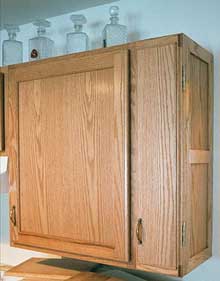
The spice rack is a chestnut, if you’ll pardon the pun, of woodworking. Homer Simpson made one. Dagwood has made more than one. Unfortunately, it’s become a symbol of the most basic kind of woodworking, the kind of project you build in your first week of shop class.
That’s why Alan Young’s spice rack caught our attention when we were recently wandering through WoodCentral’s Shop Shots. The spice rack he designed and built is an amazing combination of cabinetwork and engineering. If the spice rack of your youth is a go-cart, Alan’s spice rack is a Ferrari.
This spice rack’s design shouldn’t be too much of a surprise, all things considered. Alan spends a lot of time in the shop. He’s a technician on a cancer research project at the University of Michigan; one of his jobs is fabricating different items for medical imaging in the college’s machine shop. It takes a lot of precision to work with the materials and tools he uses every day. One machine he uses–called a wire bonder-is used to make mechanical/electrical connections on a microscopic level. Alan likens it to microscopic sewing.
So it might seem strange that, with all of the time he spends in the shop at work, that he’d want to spend even more time in the shop when he gets home. While he agrees much of the problem solving and design issues are similar, it’s very different working with wood in his own shop. “I could spend three hours in my shop at home and I wouldn’t feel like I’m doing more of the same,” says Alan.
Even with all of his design experience, he had to take two shots at this particular spice rack. He was building it for a client, and she had a vague idea of what she wanted. When he looked at the space, it immediately came to him that making it part of the surrounding cabinetry would be a perfect solution. She suggested that the spice rack swing outward, but he came up with the idea that it should slide out on drawer slides.
“I’m really pleased with it. She really likes it, and it looks so simple. But there was a major design before this one that I spent a lot of time trying to make work,” says Alan.
The speedbump in his original design turned out to be the hardware, the drawer slides. Since they were designed to be mounted vertically, his design used them that way. But after working with drawings and wood for a long time, his solution was still too big. Then it hit him: mount the drawer slides horizontally on the top and bottom of the rack. That solved most of his problems.
“It looks so simple. At least to me it looks so simple, and I wonder how I could have thought to do it any other way. And yet it took a little process to get to that,” says Alan. The rack is solid oak and is biscuit joined.
The cabinet work is a combination of solid oak and plywood. The whole project redefines the spice rack as we know it.
– Bob Filipczak





